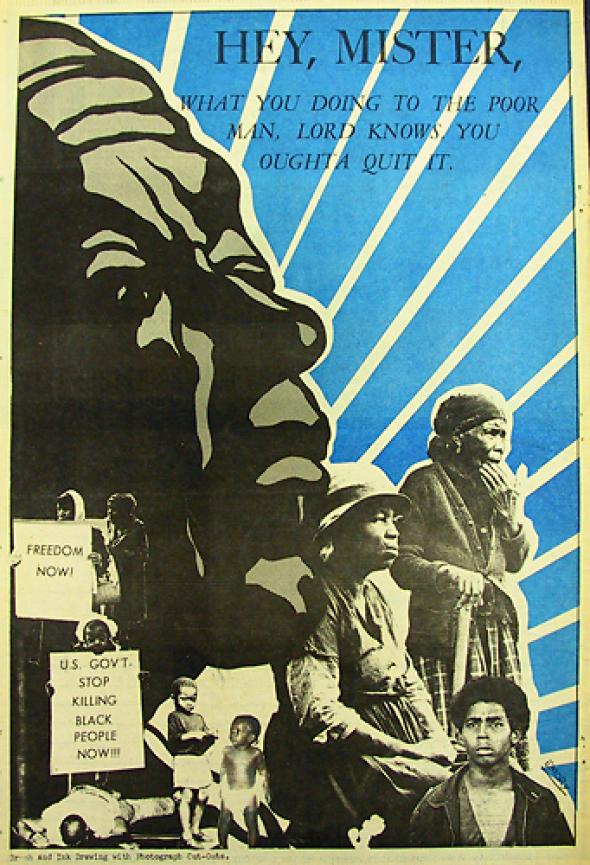Concerning Art and Social Change
The 2007 reader Art and Social Change offers a genealogy of today's radical cultures. Here, Brian Holmes and Marco Deseriis glean insights from the book into today's dilemma of producing critical culture within recuperative ‘semiocapitalism'
Among the groundswell of books investigating the link between aesthetics and politics, Art and Social Change: A Critical Reader is particularly ambitious. Published in 2007 as a companion volume to the historical survey exhibition Forms of Resistance at the Van Abbemuseum in Eindhoven, Holland, the book features a wide-ranging collection of texts and manifestos, divided into four sections corresponding to four major watersheds in contemporary social and political history: the Paris Commune of 1871, the Soviet Revolution of 1917, the social uprisings of 1968 and the 1989 revolutions in the former Eastern Bloc.
Editors Will Bradley and Charles Esche have completed the anthology by inviting six contemporary critics (Geeta Kapur, Lucy Lippard, John Milner, Gerald Raunig, Marina Vishmidt, and Tirdad Zolghadr) to provide both a historical context and an interpretation for some of the readings. However, the interpretative framework remains light enough that the core of the project resides in the selection of historical documents produced by the artists and activists themselves.
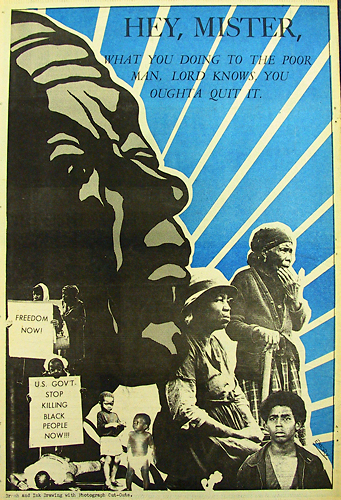
Image: Poster by Emory Douglas
Thus, a critical appraisal of Art and Social Change can only start from matters of inclusion and exclusion. Even though Bradley and Esche do not make their criteria explicit, it is fair to say that the anthology has been compiled following a genealogical approach. Rather than searching for a mythical origin and its historic continuity, a genealogy sets out to ‘maintain passing events in their proper dispersion', as Foucault explained after Nietzsche. The genealogist focuses on the numberless beginnings,
the accidents, the minute deviations - or conversely, the complete reversals, the errors, the false appraisals, and the faulty calculations that gave birth to those things that continue to exist and have value for us.1
By cutting through discontinuities and heterogeneous layers to isolate ‘different points of emergence' in history, the genealogical approach avoids any identitarian closure, leaving the reader free to invent a trajectory through the material - and crucially, to decide upon its value in the present. However, Bradley's introduction does argue that the selection retraces geographically ‘what might be termed the "globalisation of modernism"':
The conception of art primarily at issue here is a modern, Western one that has been disseminated around the planet as the social, economic, and political conditions and institutions that support it have been replicated.2
This is only partly true, as the editors downplay or ignore the socially engaged art of Southern European countries such as Italy, Spain, and Greece, the decolonisation movements of the 1960s, and the entire Asian and Australian continents where the globalisation of modernism has been under way for several decades. About a half of the selected authors are from the Americas, most notably the United States, and, in a much smaller measure, Brazil, Argentina, Chile, and Cuba. On the other side of the Atlantic, the book pays due homage to the European avant gardes with a specific focus on France, England, Germany, the Netherlands, Russia, Poland, and a handful of artists from Eastern and Northern Europe (Slovenia, Serbia, Hungary, Denmark, and Sweden). Closing gestures toward Asia and the Middle East serve primarily as a reminder of territories still unexplored.
But if we accept that this is mostly a ‘modern, Western' selection, it is nevertheless worth highlighting some thematic blind spots. Striking by its omission, for example, is the powerful mural painting movement that began around Orozco, Rivera, and Siqueiros in Mexico and went on to inspire the socially engaged artists of the United States in the 1930s. This kind of gap is perfectly comprehensible if we read the anthology as a genealogy of post-'68 practices, turned decisively away from any mass address or modernising program, emphasising instead the autonomy and singularity of each experience. But if that is the case, then it would have been useful to include texts by the subcultures and creative fringes of social movements such as the Indiani Metropolitani of the Italian 1977, the activist side of punk, and all the experiments in guerrilla communication and culture jamming that stem from the No Future generation.
The scope of the book is broad enough to reveal surprising patterns and potential alliances among experiences that took place several decades apart and under quite different political circumstances. We shall now unpack a few of them by way of a conversation that will also include some of the missing references highlighted above.
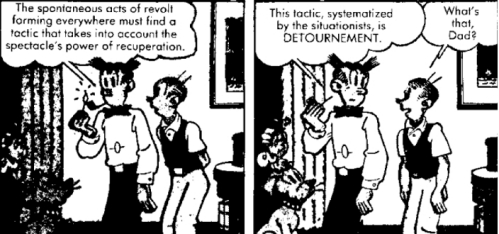
Image: Leaflet publicising the Situationist International Anthology, 1981
Marco Deseriis: The book starts from a highly symbolic historic conjuncture, the Paris Commune of 1871. At the time, the bourgeois separation between art and social praxis was a fait accompli. The industrial revolution had just dealt a fatal blow to craftsmanship - an activity in which manual and intellectual skills, the pursuit of the aesthetic and the useful were still integrated. Once production was rationalised, artworks began to be identified only by their belonging to the aesthetic sphere. The theory of l'art pour l'art reflected this status quo: the removal of art from practical life and the tendency of artworks to lose their social function. With the Commune, however, the bourgeois autonomy of art came under scrutiny. Gustave Coubert's call to artists to take over museums and art collections in the course of the uprising, and William Morris' socialist conception of art ‘as a necessity of human life which society has no right to withdraw from any one of the citizens', tell us that by the end of the 19th century artists had begun to reclaim a social function for art, in alliance with the workers' movement.3
Brian Holmes: The anthology reflects on its own departure point by including the Situationists' ‘Theses on the Commune' from 1962. For them it was a gigantic festival marked by leaderless spontaneity, clearing the ground for a kind of ‘unitary urbanism' by destroying the monuments of domination. Yet they also saw Courbet as a deluded idealist who toppled the Vendôme Column while ignoring the nearby Bank of France, ripe for looting. What really counted for the Situationists were the material results and the live aesthetic experiences of the Commune - an attitude passed on to the direct-action movements of 1990s.
There could have been another departure point, however: the 1848 revolutions, a fully-fledged cycle of struggles stretching all over Europe. In France, 1848 marked the first time urbanised workers recognised themselves as a class subject to unemployment, homelessness and starvation, and the first time they forced themselves onto the public stage of representative democracy. It's the archetypal contemporary conflict, experienced by factions of the entitled classes as a crisis of legitimacy that drove them into new political solidarities and utopian aesthetic experiments. It's clear why the editors of the anthology didn't want to sift through the flood of romantic idealism produced by that brief outburst of bourgeois experimentation. Yet here is a problem I see throughout the post-'68 left: a refusal to deal with the full complexity of social relations, and with the ambiguous or even disfigured forms they inevitably leave behind.
MD: Right, the social composition of the revolutionary wave of 1848 was very diverse and stratified. It included the urban petty bourgeoisie agitating for liberal reforms and national independence, as well as dispossessed farmers and factory workers. The thinker of the time who tried to integrate these social contradictions in a powerful aesthetic and political vision is Charles Fourier. Even if the phalanstères were designed to host the rich and the poor, and to restore social harmony without questioning the basis of capitalist accumulation, still they inspired many utopian communitarian experiments to come. Fourier conceived of labour as a pleasurable, playful activity to be modelled after human attitudes and desires. This made his theories quite appealing to the Surrealists and the Situationists, and in general to all social movements which place a high value on the productive power of imagination.
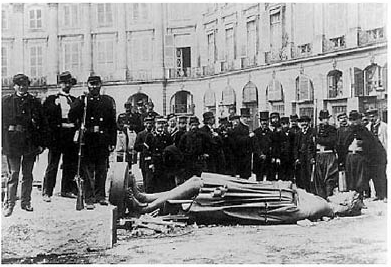
Image: Destruction of Colonne Vendôme, Paris, 1871
Fourier's vision, which is unfortunately left out of this anthology, could be seen as an early instance of what Luc Boltanski and Eve Chiapello have called the ‘artistic critique' of capitalism. Mostly developed by intellectuals, bohemians and exiles of the bourgeoisie, this critique targets the alienation and oppression derived from the Fordist organisation of labour and industrial specialisation of functions. It has been historically accompanied by the working class critique of the inequalities which stem from the unbounded accumulation of wealth characteristic of capitalism. But since this ‘social critique' of inequalities does not necessarily imply a critique of alienation and oppression, and vice versa, Boltanski and Chiapello note that, depending on historical circumstances, these two types of critique may find themselves in association or in collision.4
The social critique is represented in the anthology by two separate strands. The first runs from the Commune to Berlin Dada, the Surrealists, and after WWII, the Situationists International (SI) and the San Francisco Diggers. These groups all share the belief that art can be fully realised only by being abolished as an autonomous sphere - a task that for them is inextricably tied to the abolition of capitalism. The second strand is represented by the Bauhaus and De Stijl, which try to overcome the dichotomy between manual and intellectual work, functionalism and pleasure, by introducing new design principles into industrial production. In one respect, Russian constructivism can be associated with this second modernist strand in that it also tries to merge art and industrial production; yet on an ideological level it is closer to Dada and the Situationists in its fierce rejection of any style or aesthetics which is not subjected to the transient, historic needs of the working class.
BH: All that is well said, but to locate social critique in movements that sought either to turn art into everyday life or to fuse art and industrial design is to underscore what's been left out of this genealogy. Variations on socialist realism were spread around the world by the 1936 Popular Front against fascism, then reinvented in surprising ways by Third World liberation movements, often via surrealism. But they are barely represented here, so it's hard to grasp the affinities between the Black Panther graphics of Emory Douglas in the US, the murals of the Brigadas Ramona Parra in Chile, and the posters of the Atelier Populaire in France. The missing link is revolutionary Cuba and the Tricontinental movement, which produced an influential series of posters advocating global revolution. The inclusion of the 1972 ‘Call to the Artists of Latin America' gives an inkling of the leftist politics, but not of its visual traditions. Well, the editors found the genealogies of direct action and self-organisation more compelling, and so do I. Still, there have been fantastic political experiments with the popular languages of street art, which bear much closer relation to the workers' movement and its social critique. Contemporary groups spring to mind, like Ne Pas Plier in France, or the Grupo de Arte Callejero and the Taller Popular de Serigrafia in Argentina, not to mention ongoing muralist movements in cities like Los Angeles.
MD: Yes, the murals and the political posters you mention (to which I would add the anarchist posters of the Spanish Civil War) are only marginally represented here. The reader seems to privilege expressive forms such as performances, manifestos, and calls to action. Of course, activist murals and posters can also incite action, but the visual representation of resistance is always at risk of being instrumentalised by political vanguards, or of being turned into folk art after its ties to a living social struggle have been severed.
In this respect, Debord's analysis of the spectacle may still be relevant. The reader features another situationist text, explaining that the expulsion of 28 members was due to their refusal to renounce their artistic careers - a position deemed incompatible with the SI.5 This highlights a contradiction that keeps haunting activist art. If social movements have always expressed their imagining activity in one form or another, the culture industry puts these representations at risk of being commodified. As you noted in ‘The Flexible Personality', Boltanski and Chiapello argue that it was by neutralising social critique through economic concessions and by subsuming artistic critique that capitalism was able to enter its late phase.6
BH: The anarcho-libertarian vein of the '68 movements was selectively mined for whatever could fit into the emerging hegemony of neoliberalism. This cultural integration is the glue that holds together a disjointed system. Boltanski and Chiapello were able to document the process by a statistical analysis of '68-era terms being used in managerial literature. But they see no value in artistic critique. They lament the decline of the workers' movement and they idealise the welfare period without questioning the welfare-warfare state, but they offer no resources for the characteristic struggles of the present.
By the late 1990s it was clear that whole new dimensions of alienation were setting in, not only on the receiving end of surveillance and monitoring, but at every level of professional and freelance practice. Individuals were constantly enjoined to be more productive, more appetitive, more intensively plugged into the digital prosumer system. All that was unimaginable without new developments in what I call the semiotic economy, referring both to the frenetic consumption of signs and images and to the continuous creation of credit money on the financial markets - two inseparable phenomena. Since the dead ends of this ‘new economy' were already visible, I thought that artists should both critique the contemporary forms of alienation and find ways to revolt against them, in solidarity and collaboration with more directly oppressed and exploited people.
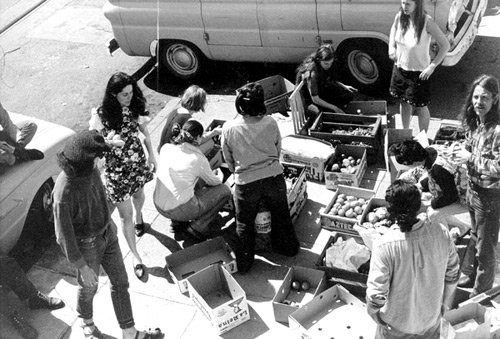
Image: San Francisco Diggers distributing free food, 1966
MD: The counter-culture was not only selectively mined to reorganise workflows around teamwork and flexibility, but also to harness its ethics of openness, sharing and decentralisation in the service of primitive accumulation in the IT sector. Fred Turner has shown how the encounter of San Francisco flower power with the technological culture of the Silicon Valley gave birth to what Richard Barbrook and Andy Cameron have labelled as the Californian Ideology, the ‘anti-statist gospel of hi-tech libertarianism', which provided the ‘spirit' of the late 1990s dotcom boom.7
In this respect Art and Social Change tells only the first part of the story. No doubt, the Diggers' ‘post-competitive game' to build Free Cities across America, and their hilarious plan of action to persuade corporate employees to abandon the workplace - summarised in the slogan ‘Give Up Jobs. Be With People. Defend Against Property' - offers a powerful blend of social and artistic critique.8 But after purging this critique of its radical aspects, flexible capital offered workers the option of fleeing the office (but not work) through the new communication technologies; to ‘be with people' by expressing their own creative and relational qualities in teamwork; and to overshadow the issue of property and distribution of wealth under the ideology of the gift economy and free access to the information society. The result is that nowadays everyone is entitled to have free internet access, no matter whether they are homeless or survive on food stamps!
The largely untold side of this story, or its ‘obscene underside' as Žižek would call it, is that the creative class quickly gentrifies the new urban districts where internet access is free but housing prohibitively expensive. Over the last two decades the cultural production of Richard Florida's ‘high bohemians' has been appropriated and re-sold at exorbitant prices by the real estate industry: in spite of their low income, artists are no longer seen as potential allies by the working class, but simply as the spearhead of gentrification.9 I think we need to ask ourselves how to reverse this trend. Where would you start from?
BH: I started by using new media to take to the streets, to spark confrontations. The thing is, spectacle has acquired a different meaning since the advent of flexible accumulation. It is no longer the homogeneous mass-produced image that characterised the state and corporate media of the 1950s and '60s. Now it is something you constantly produce through a plethora of miniaturised devices. It has to be critiqued in motion, at the heart of interactivity.
This anthology contains great insights into the sources of what is now called ‘tactical media', particularly in a series of texts running from Cildo Meireles' ‘Insertions into Ideological Circuits' to Paul Ryan's ‘Cybernetic Guerrilla Warfare'. The meeting between multimedia computers and the concept-art strategies for the activation of the viewer is directly prefigured in the alternative video movements envisioned by the journal Radical Software in 1970. Just as Meireles suggested in the Brazilian context, it is a matter of inserting subversive expressions into the very circuits where life under late capital is configured. To appropriate the media is tantamount to appropriating the means of production because, as Félix Guattari pointed out, what's at stake is the production of subjectivity.10
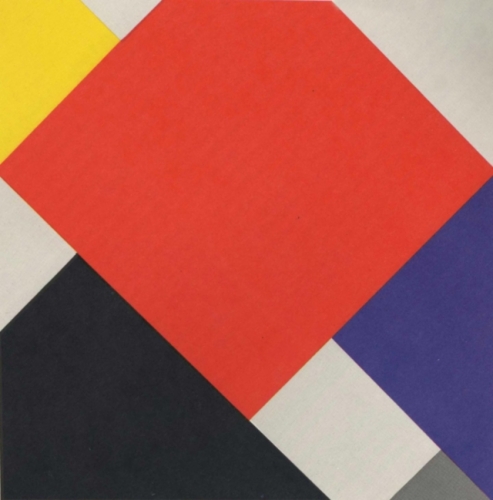
Image: Theo van Doesburg, Counter-Composition V, 1924
Later developments can be glimpsed in the glossary of net-culture terms by the Raqs Media Collective or the interview with Ricardo Dominguez, one of the founders of the Electronic Disturbance Theatre. His work resonates with the hybrid border-crossing art of Coco Fusco and Guillermo Gomez-Peña, and with the ‘invisible theatre' of Augusto Boal in 1970s Brazil, which shifted Brecht's alienation-effect into everyday spaces of performance. Figures like Boal are sources for the performative politics of the Zapatistas, with whom Dominguez has closely cooperated. So even in the most high-tech, networked performance there is a transformation of an aesthetic and revolutionary history stretching back to the Third World movements, which themselves reworked the internationalist struggles against fascism. If the anthology had included some links between the 1970s in Italy and the counter-globalisation movements, then we could trace similar lines of development in and around Europe. Unlike Boltanski and Chiapello, I don't see how cultural issues can be disentangled from the politics of life and labour. Yet there has been a real decline in the capacity of artists to arouse outrage at both alienation and exploitation. The ideological force of neoliberal culture has been amazingly effective.
MD: In my view, there are two major reasons why the critique of alienation has withered. The first one is that as the opportunities for activists to insert themselves into the ‘ideological circuits' increased, the feeling of being just another spectator declined (Indymedia's motto ‘Don't Hate the Media, Become the Media' perfectly exemplifies this shift). With the emergence of the network society it is increasingly problematic to claim, as Debord did, that the spectacle is simply the language of capitalist separation, that is, a one-to-many relationship which rigidly divides ‘what is possible from what is permitted.'11 In recent years, the single Spectacle has been accompanied by many spectacles which open up new political imaginaries while enhancing the autonomy of their producers.
The second reason why the 1960s artistic critique of alienation is no longer effective is that the new machines have become, as Donna Haraway once said, our ‘intimate components' and ‘friendly selves'.12 Since these machines enable a strange mix of repetitive and creative tasks, manual and intellectual activities, revolting against them would be like revolting against ourselves. But if in the age of networked publics every social and linguistic activity is immediately put to work, how can we produce subjectivities that do not simply feed capital? The text ‘How To?' by the Tiqqun group, which can be criticised for its ambiguous celebration of political anonymity and insurrectionalist mystique, advances the idea of the Human Strike.13 From my understanding, this is a strike against the production of fake subjectivities and critiques which are not rooted in local communities sharing strong affective bonds. This could be read as a critique of the tactical media scene, and more broadly, of the tendency to generate critical discourses detached from any need to transform society from the ground up.
BH: ‘How To?' is a poetic call to insurrection, resonating with a number of recent revolts. Tiqqun has developed a radical critique of cybernetic society, which they see as a total mobilisation of the ego for meaningless labour and consumption. Of course that implies a critique of tactical media, which has been largely neutralised by corporate and government sponsorship. Tiqqun proposes an anti-aesthetic, a way of cutting the feedback loops that bind us to our marketised selves. It is linked with a rising desire to exit the cities; but with an obvious difference from 1960s utopias, of the kind represented in the reader by the fascinating, yet little-known artist Bonnie Sherk with her text on the social art work of ‘The Farm' in San Francisco. A more or less violent aesthetics of withdrawal from neoliberal networks is now being expressed in many countries, because it's one way to begin shifting towards a new paradigm. A very dangerous way, however - which could also justify further escalations of the military-police state and the durable installation of authoritarian neoliberalism.
In the early part of this decade, I hoped that networked social movements could theatricalise the real social relations of neoliberal society, suspending its functional norms and opening up space and time for collective questioning. That was done by unleashing an unauthorised circulation of subversive ideas, to be embodied by militant groups in urban situations. Or anyway, that's how I explained it in ‘The Revenge of the Concept', included in this anthology. Those protests worked to a degree, because there has been an intense examination of neoliberalism including both social and ecological critiques. Now I'm hoping that social movements can influence the new economic paradigm that will ultimately emerge from the crisis, by inventing critical and poetic discourses, shaping viable territories and constructing cooperative machines. Leafing through the reader, I find myself wondering if our times can produce anyone like Theo Van Doesburg, who was both a dadaist and a member of De Stijl, and who called destructively for the end of art while designing a constructivist aesthetics of built environments. But that reference is a bit too genealogical! What do you see as the discontinuous breakthroughs of the present?
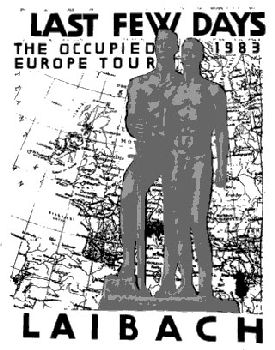
Image: Laibach poster, The Occupied Europe Tour, 1983
MD: I think we need to start by relocating the forms of alienation. As Matteo Pasquinelli points out in his new book Animal Spirits, the libidinal economy of the network society generates a symbolic surplus-value that the real estate market tries to parasite and put to work in the new creative districts of the world cities.14 The fact that information is an abstract, non-rivalrous good does not mean that its wealth cannot be appropriated and congealed into (private) space. From this flows the notion that the critique of intellectual property cannot be separated from a critique of material property and of rent, that is, of the earliest form of capitalist property.
In the contemporary factories of biopolitical production, artists are the urban pioneers who identify the hotspots in advance. Therefore it is their duty to ask themselves how to retain the value they produce through their common imagining activities and cultural production within the community in which they live. The reader features a great article on the group Park Fiction, which describes the successful struggle of a Hamburg association of residents to design and obtain a public park through a participatory planning procedure in the historic district of St. Pauli, against the attempts of the city to gentrify it.15
On a symbolic level the critique of alienation can take on many different forms. Personally I am fond of collective experiments such as Laibach, Luther Blissett, etoy, Ubermorgen, Rtmark, Yo Mango! and others which subtract themselves from the hegemonic field by changing the very coordinates in which they operate. The music and performances of Laibach exemplify this strategy perfectly. By juxtaposing industrial sounds, pop songs, totalitarian symbols, and avant garde art, Laibach restages the foundational violence of the nation state and of every spectacle. As they say in their manifesto, the Ten Items of the Covenant, included in the reader: ‘All art is subject to political manipulation [...] except for that which speaks the language of this same manipulation.'16
It is important to recognise, however, that Laibach's performances do not only target pop culture and totalitarian ideology but also art itself, in particular the will to power of the avant garde. I believe that a new artistic critique of alienation cannot ignore the basic fact that art is a form of power. This is particularly true now that art is no longer used, as in totalitarianism, to aestheticise politics, but to redesign the urban space according to the shifting needs of semiocapitalism. In this respect it would be very important to update Lefebvre's analysis of the accumulation and distribution of power in urban space, to stimulate practices of reappropriation in which artists could play an important role. After all Lefebvre's The Right to The City, written in 1967, became the slogan of a whole movement.17
Marco Deseriis <snafu AT thething.it> is a Ph. D. Candidate in the Department of Media, Culture and Communication at New York University. He has co-authored, along with Giuseppe Marano, a book on Net.Art (Shake, 2003-08) and collaborates with the festival of Culture Jamming and Radical Entertainment The Influencers, http://theinfluencers.org
Brian Holmes <brian.holmes AT wanadoo.fr> is a cultural critic, living in Paris and Chicago, working with artistic and political practices. He is the author of Hieroglyphs of the Future: Art and Politics in a Networked Era (Zagreb: WHW, 2002) and Unleashing the Collective Phantoms: Essays in Reverse Imagineering (New York: Autonomedia, 2008). He currently collaborates on the Continental Drift seminar with the 16 Beaver group in New York. Forthcoming book and text archive at http://brianholmes.wordpress.com
Info
Will Bradley and Charles Esche (eds.), Art and Social Change: A Critical Reader, Tate Publishing UK, 2008
Footnotes
1 Michel Foucault, Language, Counter Memory, Practice: Selected Essays and Interviews by Michel Foucault, trans. and ed. Donald F. Bouchard, Ithaca, NY: Cornell University Press, 1977, p.146.
2 Will Bradley, ‘Introduction', in Will Bradley and Charles Esche (eds.), Art and Social Change: A Critical Reader, London: Tate-Afterall, 2007, p.11.
3 William Morris, ‘The Socialist Ideal: Art', in Art and Social Change, p.50.
4 Luc Boltanski and Eve Chiapello, The New Spirit of Capitalism, trans. Gregory Elliott, London: Verso, 2007.
5 Situationist International (J. V. Martin, Jan Strijbosch, Raoul Vaneigem, René Viénet), ‘Response to a Questionnaire from the Center for Socio-Experimental Art', in Art and Social Change, pp.125-9.
6 Brian Holmes, ‘The Flexible Personality: For A New Cultural Critique', in Hieroglyphs of the Future, Zagreb: WHW/Arkzin, 2002. Available at http://transform.eipcp.net/transversal/1106/holmes/en
7 Fred Turner, From Counterculture to Cyberculture: Stewart Brand, the Whole Earth Network and the Rise of Digital Utopianism, The University of Chicago Press, 2006; Richard Barbrook and Andy Cameron, ‘The Californian Ideology', available on multiple websites, including www.alamut.com/subj/ideologies/pessimism/ califIdeo_I.html
8 The San Francisco Diggers, ‘Trip Without A Ticket', and, ‘The Post-Competitive, Comparative Game of a Free City', in Art and Social Change, pp.146-56.
9 Richard Florida, The Rise of the Creative Class: And How It's Transforming Work, Leisure and Everyday Life, New York: Basic Books, 2002.
10 Félix Guattari, ‘On the Production of Subjectivity', in Chaosmosis: An Ethico-Aesthetic Paradigm, Indiana University Press, 1995.
11 Guy Debord, Society of the Spectacle, trans. Ken Knabb, London: Rebel Press, 2002, p.14.
12 Donna J. Haraway, Simians, Cyborgs, and Women: The Reinvention of Nature, New York: Routledge, 1991, p.178.
13 Tiqqun, ‘How To?', in Art and Social Change, pp.297-312.
14 Matteo Pasquinelli, Animal Spirits: A Bestiary of the Commons, Rotterdam: Nai Publishers, 2009.
15 Christoph Schäfer and Cathy Skene with the Hafenrandverein, ‘Rebellion on Level P', in Art and Social Change, pp.283-9.
16 Laibach, ‘Ten Items of the Covenant', Art and Social Change, p.251.
17 Henri Lefebvre, ‘Right to the City', in Writings on Cities, trans. and ed. Eleonore Kofman and Elizabeth Lebas, Cambridge, MA: Blackwell, 1996, pp.63-177.
Mute Books Orders
For Mute Books distribution contact Anagram Books
contact@anagrambooks.com
For online purchases visit anagrambooks.com


